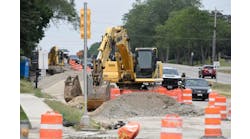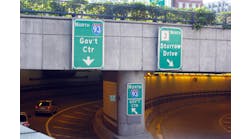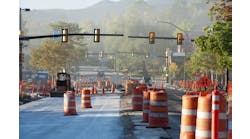Shortly after 6 p.m. on Wednesday, Aug. 1, the I-35W bridge span over the Mississippi River in Minneapolis collapsed. The tragedy claimed the lives of 13 people and injured hundreds. On a normal day, 140,000 vehicles passed over the eight-lane 1,907-ft-long, 40-year-old steel truss arch bridge.
While local and national media attention focused on uncovering the cause of the collapse and fast-track rebuilding plans, the four-year, $280 million Crosstown Commons Reconstruction project continued unabated. Steve Barrett, project manager for the Minnesota Department of Transportation (Mn/DOT) reported, “Everybody paused and caught their breath for a day or two and then went back to full-time work.”
Two months earlier, on Saturday, June 1, construction workers started dismantling the Diamond Lake Road Bridge that crossed over the I-35W highway. Demolition of the bridge marked the first step in a project to transform one of the most congested freeway exchanges in the Twin Cities metropolitan area.
Strengths in numbers
Every day, 250,000 cars travel through the I-35W Crosstown Commons. In the last few years, freeway commuting has shifted from a quick trip to mind-numbing, frustrating bumper-to-bumper traffic and road-rage-fueled drivers jockeying for position. Congestion tangles the area for as much as 13 hours each day. According to Mn/DOT, the accident rate in the Commons area is three times the average throughout the metropolitan area.
The Crosstown Commons combines four miles of I-35W aligned north and south with Highway 62 moving east and west through Richfield, a first-tier suburb, and the city of Minneapolis. The original interchange was built in the 1960s, and the area’s population growth has far outstripped the highway’s capacity.
Initial planning to resolve the congestion began in the late 1990s. Construction plans presented in 2001 were rejected after citizen groups called their legislators to complain about construction closures and the absence of additional capacity. An advisory committee was formed to investigate options and oversee plan revisions, and approved construction plans were completed in February 2006.
Slated to begin in August 2006, the Mn/DOT project bid included an unusual requirement calling for contractors to partially finance the project until Minnesota could reconcile a shortfall between federal and state construction funds. The August 2006 bid deadline passed without any submitted bids.
In March 2007, after years of political wrangling and construction financing delays, Mn/DOT awarded the Crosstown Commons construction project to the joint venture of Ames Construction Co. in Burnsville, Minn., Shafer Contracting, Shafer, Minn., and Lunda Construction, headquartered in Black River Falls, Wis.
Mike Macarthur, project manager for the joint venture, reported, “Each contractor is playing on their strengths in terms of expertise and resources. Lunda is primarily focused on the bridges and concrete work. Shafer is doing the sand, gravel and concrete paving. Ames Construction has extensive experience building all over the country. Our focus will be on managing the process, coordinating subcontractors and building bridges, retaining walls and noise walls.”
John Griffith, Mn/DOT’s west area engineer/project engineer, has been involved in the preconstruction design since 2001. “We took a turnkey approach to the design and hired one consultant [SRF Consulting, Minneapolis] to do the predesign, final design, predesign of the bridges, water resources and right-of-way processes,” he said of the early design process. “They were given the task of developing the project. Typically we would have subcontracted some of that work and kept other parts of it in house. I don’t know if we could have done this internally and farmed out little pieces here and there and still get a design in the short amount of time we did it.”
Checkered present
The complex project required reconstructing the heavily traveled I-35W and Crosstown Highway 62 interchange to increase capacity and remove a series of lane weaves as the two highways mix and separate in a mile-long stretch.
An aggressive schedule is planned to complete the project by the November 2010 due date. The construction staging calls for building new roads next to the existing highway. “We are building roads outside of the existing traffic, then switching traffic on the new roads to build the middle,” said Macarthur. “As you do that you have traffic on both sides of the construction. It certainly makes it difficult for access and building when you are dealing with that volume of traffic. The sooner we can move traffic on to some of these stages the sooner we can move to subsequent stages. That will have the biggest effect of reducing the time.”
At the three-month mark, Barrett was pleased with motorists’ ability to get through the construction zone with relatively little delay. “We’ve been able to maintain that [traffic flow] about the same as it was when we started. It was a notoriously congested area but I don’t think it’s gotten much worse.”
According to Griffith, previous highway construction projects throughout Minnesota frequently used cast-in-place retaining walls. The Crosstown Commons project will utilize mechanically stabilized earth retaining walls to speed construction and reduce overall costs. The large flyover bridges will be constructed from precast segmental box beams rather than traditional steel girders.
Griffith explained the advantages, “The traveling public isn’t seeing the construction of those boxes on-site. A bridge segment is brought into the project area and assembled. The disruption to traffic is actually just setting that piece rather than building it and casting a frame around it.
“Once you get the casting area set up and they start manufacturing the pieces those bridges tend to go up a little quicker.”
Given a 24/7/365 timeline, contractors will work through Minnesota’s frigid winter without hesitation. Macarthur said, “The winter does affect our grading operations and concrete paving, but we’re pretty accustomed to that. We know how to work the construction project around it.”
Segmental bridge work could be affected by cold temperatures. “There is a temperature restriction on when the segmental sections can be placed. Generally in the winter we can do a lot of the cast-in-place work because the concrete still generates a fair amount of heat. So you can still do substructure work,” added Macarthur.
Neighborly of them
Located in a densely populated metropolitan area, the Crosstown Commons design process has been watched carefully by area citizens. Responding to calls for additional mass transit opportunities, the reconstructed highway will include a combined HOV/BRT (Bus Rapid Transit) transit lane.
Griffith reported, “We will have the first online transit station in Minnesota and just the second in the United States. Buses will exit 35W to a center island transit station, stop and pick up people coming down from the top of the 46th Street bridge, who will enter the buses and continue on to downtown Minneapolis.”
Demolition and reconstruction of the Diamond Lake Road Bridge over I-35W did raise concerns at the nearby Museum of Russian Art. Barrett explained, “They were definitely concerned about vibrations from the construction being so close to the building. We had a consultant with seismographs monitoring vibrations during the demolition of the old bridge and pile driving for the new bridge.”
Mn/DOT hired CNA Consulting Engineers, Minneapolis, to monitor vibrations close to the museum and near other older homes and businesses located close to the piling operations. To date, Barrett reported, “We have not had any reports of vibration exceeding what’s considered an allowable amount.”
Communication is a critical component. For the first time, Mn/DOT required the design-bid-build contractor to have a communications person as part of their team. Griffith said, “We’re in such an urban residential environment, we are trying to address as many of the complaints as we can and get in front of the communications issues.”
The Mn/DOT team addressed a range of potential issues by creating an animated project presentation. “The animation gave us the ability to show a before and after picture and do an aerial fly through of the project showing the existing conditions and overlaying what the project will look like in the future. That visual was very powerful in terms of us moving forward with the project by calming some of the fears the neighborhoods had,” described Griffith.
An extensive use of sound walls will protect residential neighborhoods from rush-hour road racket. Wood facings mounted on concrete posts will offer aesthetic texture and improve the appearance of the new construction.


